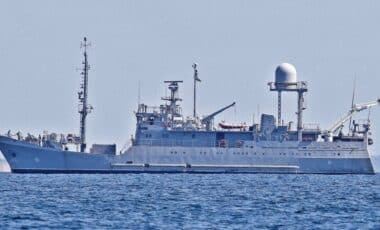The U.S. Navy has spent decades shifting away from the Mahanian world of sea power, but with the rise of China, it is now embracing a more combat-oriented approach to maritime strategy. This long-overdue course correction is focusing on rebuilding capabilities that had been sidelined in favor of peacekeeping and constabulary duties.
Historically, the U.S. naval strategy evolved from a post-Cold War mindset of unchallenged dominance to a renewed focus on peer adversaries, particularly China. As the Chinese navy rapidly modernized and expanded, the U.S. is increasingly realigning its forces to reclaim strategic maritime supremacy, drawing inspiration from the classical theories of naval strategist Alfred Thayer Mahan. The central challenge now is to adapt to a new, high-stakes maritime environment where America’s naval forces face a rising, formidable competitor.
World’s Largest Gas Field Hit: Israel Takes Aggressive Step in Iran Conflict
The Rise of China and the Return to Mahanian Strategy
The United States’ naval approach shifted in the post-Cold War era, moving away from the confrontational tactics championed by Alfred Thayer Mahan. During the 1990s, the U.S. Navy’s strategy focused on preventing regional conflicts and policing global maritime traffic.
This post-Mahanian mindset assumed that peer-level naval challengers no longer existed. However, with China’s growing naval ambitions, the U.S. has faced a wake-up call. According to James Holmes, a professor at the Naval War College, the U.S. “vacated the Mahanian world of sea battle at almost precisely the historical instant China entered it “, reports The National Interest. As China’s naval capabilities advanced, the U.S. began to realize the importance of regaining its traditional sea power posture to maintain influence in critical maritime regions.
This shift, which began around 2012, reflects a recognition that America’s maritime strategy must become more adversarial. With China directly challenging U.S. interests, particularly in the Indo-Pacific, the U.S. Navy is revisiting Mahan’s focus on securing control over sea lanes and projecting power across the oceans.
The Importance of Joint Sea Power
The modern U.S. maritime strategy is not just about revamping naval power but integrating it with other military and technological domains. Today, joint sea power involves more than just the Navy. As Secretary of Defense Mark Esper emphasized at the Shangri-La Dialogue in Singapore, the U.S. is increasingly focusing on joint operations that include the Army, Air Force, Marine Corps, and Space Force.
According to Holmes, the combined efforts of these branches are vital for denying China access to the strategic areas around the first and second island chains. These areas are crucial in limiting China’s ability to project power across the Western Pacific and safeguard American interests.
The transformation is evident in the U.S. Marine Corps’ new focus on island defense and the Army’s adoption of “Multi-Domain Operations.” These changes illustrate a significant shift towards making every service a participant in maritime strategy. The integration of aerospace, cyber, and even space-based capabilities ensures that the U.S. has a comprehensive and multifaceted approach to counter China’s growing maritime assertiveness.
The Need for a Centralized Maritime Strategy
While the U.S. has made strides in its military restructuring, one persistent issue is the lack of a unified maritime strategy. Currently, responsibility for maritime affairs is fragmented among various agencies, including the Navy, the Department of Homeland Security, and the State Department. According to Holmes, this disjointed approach complicates efforts to effectively manage America’s sea power. A more centralized command, potentially through the National Security Council, could ensure a more coherent and coordinated strategy across all branches of government and the private sector.
The lack of a cohesive maritime strategy also affects the U.S. relationship with its allies. While America has historically been the dominant force in international maritime coalitions, future success will depend on multilateral cooperation. Holmes highlights the need for a “thousand-ship navy,” a concept that calls for greater contributions from international partners.
If the U.S. hopes to remain competitive with China, it must not only lead but also coordinate efforts with global allies to ensure a united front in protecting critical sea routes and maintaining free trade.








